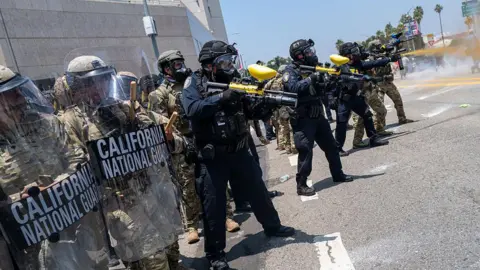In June 2025, a considerable upheaval transpired in the city of Paramount, California, closely linked to the growing anxieties surrounding immigration policies under President Donald Trump’s administration. The focal point of this unrest was a Home Depot—a hardware store—where long-standing tensions erupted over rumors of immigration enforcement activities. Local immigrant laborers, predominantly undocumented individuals, usually congregate there seeking work. However, the atmosphere turned fraught when reports circulated about potential raids targeting these workers.
Juan and his friends stood in the dimly lit parking lot of the Home Depot, surrounded by an eroding sense of community and safety. Generally, their crew would comprise numerous laborers, but on this notable Sunday, only a handful remained. The stark change reflected an air of uncertainty following a flurry of alarming sightings of immigration enforcement vehicles in the vicinity. Residents claimed to have observed agents looming nearby, intensifying an already palpable fear that gripped the 82% Hispanic population in the area.
Tensions peaked when misinformation regarding arrests spread through word of mouth, igniting a response from the community. Many residents misinterpreted these sightings as raids, leading to a deluge of protests. Demonstrators took to the streets, expressing outrage over what they believed were unjust actions against their peers. Rock-throwing and Molotov cocktails characterized the protests, resulting in tumultuous confrontations with law enforcement, which responded with pepper spray, rubber bullets, and smoke bombs to quell the growing flames of chaos.
As the day unfolded, the protests morphed into something more destructive, drawing national attention and prompting authorities to label the situation as a riot. The U.S. Department of Homeland Security later countered these claims of a Raid, insisting that there was no formal Immigration and Customs Enforcement (ICE) operation taking place at the Home Depot store. The agency publicly addressed the false reports but nevertheless acknowledged that some migrant detentions had taken place elsewhere in the Los Angeles area that week, which further complicated the narrative and solidified fears among the local immigrant community.
By this time, armed members of the California National Guard were deployed to the area, marking an unprecedented federal intervention during times of social unrest. President Trump ordered the Guard’s activation in response to the explosive protests, asserting that these actions were essential to maintaining order. National Guard vehicles lined the streets, with troops present to monitor the ongoing disturbances, a visible reminder of the escalating political tensions in the region.
Amid the turmoil, local voices echoed stories of resilience and fear. Protesters like Maria Gutierrez expressed the deep-seated frustrations felt by many from the immigrant community. She reflected on the strong ties among local families, many of whom have undocumented members, and reiterated a collective sentiment that resonated throughout the crowds: “It was time to stand up,” she passionately declared. For those within the immigrant enclaves of Los Angeles, the implications of these protests transcended mere political rhetoric; they represented a crisis of identity and belonging in a city that many now consider home.
As the nation tuned in to the events unfolding in Los Angeles, it shone a spotlight on the broader questions regarding immigration policy in America. Though the demonstrations were initially spurred by fears and misinformation, they served as a catalyst for dialogue about the realities faced by undocumented immigrants amid increasingly harsh enforcement measures. Community members gathered in places of faith, like the Chapel of Change—holding discussions that encompassed their aspirations, histories, and the struggles that lie ahead.
In summary, the fervor that engulfed Paramount served as a pivotal moment in the narrative surrounding immigration in the U.S. The tension between local communities and federal enforcement agencies highlighted the intense feelings of vulnerability felt by many and underscored the need for greater understanding and compassion in addressing the complications of immigration within the American landscape. The richness of shared histories and the blend of cultural heritages in Los Angeles continued to weave a complex tapestry of identity, devotion, and resilience in the face of adversity.



